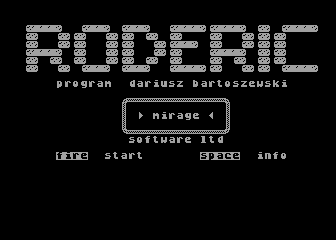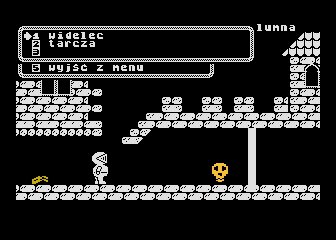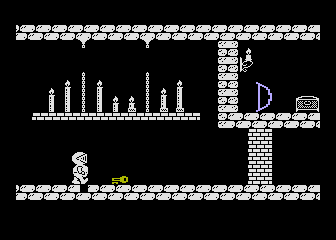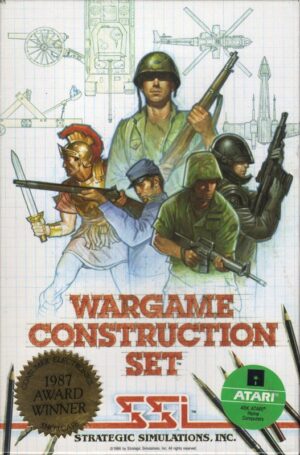Retro Replay Review
Gameplay
Roderic delivers a classic platform-adventure experience that hinges on exploration, careful inventory management, and well-designed puzzles. Players must scour every nook and cranny of Godart’s keep—its first floor, basement, and rooftop—to discover keys, potions, and magical herbs. The limitation of carrying only three items at once forces you to think ahead: deciding which objects to bring along and which to leave behind can be the difference between victory and an untimely demise.
(HEY YOU!! We hope you enjoy! We try not to run ads. So basically, this is a very expensive hobby running this site. Please consider joining us for updates, forums, and more. Network w/ us to make some cash or friends while retro gaming, and you can win some free retro games for posting. Okay, carry on 👍)
Combat is minimal but tense. Rather than hack-and-slash, Roderic utilizes a few simple spells and cleverly applied herbs to neutralize distant threats or trigger environmental reactions. This subtle magic system feels weighty because each spell requires the right combination of reagents, and misusing them can render you vulnerable to deadly traps such as falling chandeliers or poison-filled chambers.
The game’s puzzle design is its strongest suit. Whether you’re using a fire potion to melt ice barriers, a bouncing seed to reach high platforms, or a light-emitting crystal to reveal invisible pathways, each challenge pushes you to experiment with the three-item limit. Some puzzles demand precise timing, while others hinge on foresight—stockpiling the right items early and carrying them through the elevator to a new level to unlock hidden passages.
Graphics
Roderic’s visual presentation embraces a retro-inspired pixel art style, yet the team has injected modern touches that give the castle a palpable atmosphere. Dimly lit corridors flicker with torchlight, and subtle parallax scrolling on the roof level adds depth to the starry sky above. Character sprites are expressive, bringing Roderic’s determination and Godart’s malevolence to life in just a few pixels.
Environmental variety keeps exploration fresh. The basement groans with rusted chains and dripping water, while the rooftop is battered by gusting winds that sway lanterns and threaten to push you off narrow ledges. These can look dramatic on-screen, and the animation quality—though pixelated—feels smooth and intentional, avoiding the jitteriness that plagues some indie platformers.
Lighting and color palettes shift dynamically between levels. Warm earth tones in the first floor hallways give way to sickly green hues in the trap-laden lower levels, then to cool blues and purples under the night sky. Each area feels cohesive, guiding you visually through the narrative progression of intrusion, danger, and escape.
Story
The narrative hook is simple but effective. Godart, the evil wizard, has kidnapped Princess Fiscella and smugly accepts Roderic’s self-sacrifice as a lavish ransom down payment. What he underestimates, though, is Roderic’s proficiency in arcane lore. A quick conjuration of spells and herbs sends Godart packing—literally dissolving his body into nothingness—and leaves Roderic stranded in the very dungeon he sought to breach.
This premise sets up a classic rescue mission with a twist: you’re not fighting the antagonist directly; you’re navigating the aftermath of his disappearance. The castle itself becomes the final boss, filled with lethal traps and locked doors, forcing Roderic to use intellect over brute strength. Bits of narrative—tattered journals, flickering magical sigils, and hushed audio logs—provide context, fleshing out Godart’s experiments and hinting at Fiscella’s fate.
Dialogue is minimal, letting the environment and item descriptions convey most of the lore. This approach keeps the momentum brisk and places you squarely in an explorer’s mindset: constantly scrutinizing your surroundings for clues. While some players may crave more character interaction, the sparse storytelling ensures that the puzzles and platforming remain front and center.
Overall Experience
Roderic excels at blending old-school platforming with clever inventory-based puzzle solving. The moderate difficulty curve rewards patience and experimentation, and the compact scope—three distinct levels—feels just right for a single-session adventure without overstaying its welcome. Moving between floors by elevator adds a smart connective thread, reminding you that every item you pick up might solve a challenge elsewhere.
While the pixel art is charming, some players may find the challenge peaks steep, especially when juggling multiple items under time pressure or reacting quickly to deadly environmental hazards. However, these moments of high tension also lead to some of the game’s most satisfying breakthroughs: spotting a hidden switch, improvising a new spell combo, or narrowly outrunning a trap just before it snaps shut.
For fans of classic 2D adventures who value brain-teasing puzzles as much as precise platforming, Roderic offers a memorable castle escape. Its evocative visuals, resourceful magic system, and thoughtfully crafted levels come together to create an experience that rewards careful planning and quick reflexes in equal measure. If you’re searching for a bite-sized journey that challenges both mind and muscle-memory, Roderic is well worth your time.
 Retro Replay Retro Replay gaming reviews, news, emulation, geek stuff and more!
Retro Replay Retro Replay gaming reviews, news, emulation, geek stuff and more!









Reviews
There are no reviews yet.